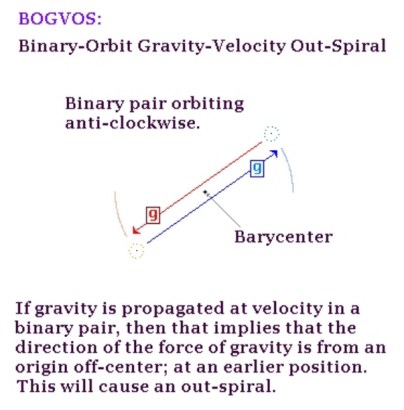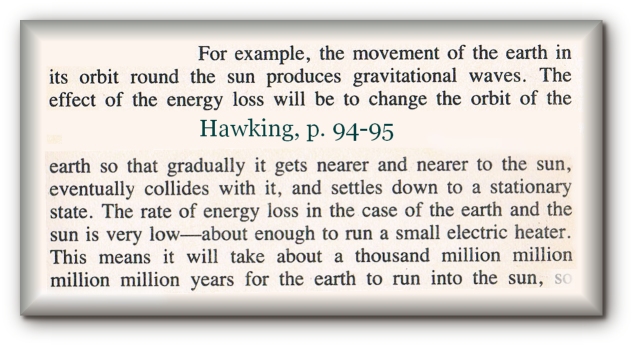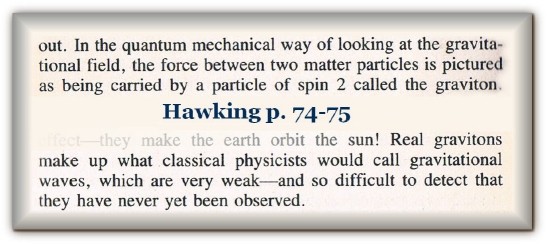| Gravity Proved Instantaneous Because
Sum Theory is in disagreement with the popular paradigm of Relativity,
certain aspects of General Relativity need to be examined. When
investigating how all the various principles and interpretations
of Einstein’s Relativity could effect the solar system and
planetary orbits, we first need to dismiss as negligible, the small
inwards spiral from General Relativity which for the orbit of the
Earth is said by Hawking in A Brief
History of Time to be: |
||
|
This amounts to an inwards spiral rate of 1mm for 500 times the age
of the Universe. It must be noted that the ‘Numerical Relativists’
and the LIGO group could have interpreted this in a way which is quite
different to Hawking; far more rapid, but which remains rather opaque
from a purely formulaic perspective in their articles.
In the GW150914 experiment they conclude that such an inward spiral when applied to a pair of black-holes in very close proximity spirals inwards at over 3000km per second. (Vitally this is not the orbital velocity of the pair of bodies, but the rate of them moving towards one another in a ‘radial’ direction). I can find no reference to how they get that result from historical non-internet sources of General Relativity. And thus I can only conclude as a matter of form, that LIGO are not using Einstein’s Relativity to attain such an in-spiral. Instead, it seems, their process should be considered as ‘Numerical Relativity’ – another theory entirely; albeit based somewhat on Einstein. A simple energy conservation calculation will serve to show that the two theoretical claims of inward spiraling orbits are not the same: If the combined solar masses of the black-hole binary are 20 million times greater than the Earth, then this would equate to 20 million electric heaters (Hawking’s unit of measurement). This is the energy output of a city, which is certainly not enough to move 66 solar masses 350 kilometers in 0.1 seconds – as the LIGO experiment suggests. Thus the proof that the in-spiral of the Numerical Relativists is quite different from Hawking’s historical narrative is just a sum. And it is a sum that checks the two as being different by a factor with more logarithmic zeros than is even worth counting. However, it is widely quoted that Numerical Relativity is in keeping with General Relativity on most websites. A vital way to see that there is a categorical difference between the two theories is that According to Hawking, it is a loss in velocity that is the source-energy for gravity, whereas for the Numerical Relativists, the object somehow loses mass in order to provide the source energy for gravitational-waves. But the Numerical Relativists make another glaring historical omission because at no point is Special Relativity even mentioned in their analysis. And for Einstein, Special Relativity is a priori to General Relativity. The obvious problem being that in Special Relativity, an increase in velocity causes an increase in mass – whereas the Numerical Relativists have a decrease in mass with an increase in velocity. It seems entirely contradictory for Einstein to suggest that Special Relativity yields an increase in mass with increased velocity whilst General Relativity would have a decrease in mass with increased velocity. If he did claim this, then that would show that his two theories contradict one another on their own terms. That is why I take Hawking’s quote of a decrease in velocity as the source of energy for gravitational-waves, as being historically correct. Most websites seem to have copy-pasted the Numerical Relativists error (or re-conception) of the source of gravitational energy being a loss in mass. This topic is discussed at length in the previous Chapter XXIX: Analysis of GW150914. Because my analysis is at odds with most other internet sources, I am of course expecting it to be contested and unduly vilified. This is the way pop-physics operates: it is little more than crudely democratic herd-instinct. Logical issues are seen as less important than popularity. So it is important to realize how I am claiming, besides everything else, that General Relativity should have a purely geometric effect on orbits that nobody else has noticed or even considered. This is a purely logical consequence of gravity moving at the velocity of light. Be careful here, because to counter this, the sophists will typically try and refocus the topic of discussion into an area that has nothing to do with the geometrical consequence of gravity having velocity. Stick to the issue! Let
us look more closely at how Hawking explains gravitational-waves: |
||
|
So it is quite clear that regardless of whether we are looking at
Quantum Mechanics or Relativity, gravity is still a force measured
in Newtons – and it is still holding you down on the Earth.
Of course since then, the LIGO group have claimed to have detected
gravitational-waves and determined the speed of gravity: . |
||
|
So regardless of descriptions such as ‘space-time’,
General Relativity is still certainly claiming (in the above quotes)
that gravity is a force traveling at the ‘speed of light’.
And, it is abundantly clear that Relativity is thus also inadvertently
claiming that there will be a delay in the gravity – because
gravity is said to travel at the ‘speed of light’! It
is truly astonishing at how many people have mindlessly rehearsed
the incorrect notion that General Relativity is not claiming that
gravity is traveling at the velocity of light. Nobody ever seems
to consider how the speed-of-rumor is much faster than the speed
of reading an actual book!
Now this delay of gravity occurs in both directions between any pair of celestial bodies. It is an effect which the Sun has on the Earth and also the lesser gravity which the Earth has on the Sun. This delay has an increased effect when both objects travel at higher velocities and at larger distances apart. Scenario
[1] in the algorithm
orbit-gravity-sim-12.exe (OGS12)
is a hypothetical pair of dense white-dwarf stars orbiting anti-clockwise
in close proximity. This shows the effect of gravity-velocity
at it most visibly pronounced scale: |
||
 |
||
|
It is astonishingly clear that if gravity is delayed, then it will
pull in the direction, that the opposing body was, and not in the
direction that the opposing body actually is. That is why there
is a clearly marked difference between the position and the gravity-origin
in the graphic above.
This
difference is demonstrated in the OGS12 algorithm (orbit-gravity-sim-12.exe)
which generated the image above. The orbit-line is thus depicted
as visibly trailing behind the center of the star by 107.858km
in this snapshot example because: gravity is delayed. The result
of this delay on the geometry of an orbit is a concept that has
been termed BOGVOS: Binary-Orbit, Gravity-Velocity, Out-Spiral. |
||
 |
||
|
Now the example in Scenario [1]
is fairly extreme (albeit nowhere near as extreme as the LIGO GW150914
binary). Both white-dwarf stars are very dense; only 600km across,
whilst weighing each twice the mass of the Sun – and only
a few thousand km apart, and they are thus moving at 1.3% the velocity
of light. That is why the effects are clearly observable –
this hypothetical pair would spiral outwards enormously.
As we saw earlier, in the context of the orbit of planet Mercury, this same outward spiral from the gravity-velocity of General Relativity becomes much smaller than the inward spiral for Special Relativity. This is because the effect of Mercury’s tiny mass on the Sun is very small, and only barely able to be calculated. Mercury shifts the Sun by a tiny amount on each orbit attaining a very small velocity. Mars is in the same category as Mercury in this regard – a low mass body in an eccentric orbit. Scenario [15] of the OGS12 algorithm depicts a hypothetical satellite near the Sun called ‘Daedalus’ which is a more extreme example of Special Relativity overpowering General Relativity’s effect on orbits. For all the other examples in this study: Venus, Earth, Jupiter, the Moon and the Alpha Centauri binary – it is the outwards spiral caused by a delay in gravity traveling at the velocity of light that is the dominant Relativistic effect. In these examples all of the other various principles of the Relativities in orbital structures have been computed to have considerably less effect than gravity moving at velocity. It is important to realize that this effect is simply a logical consequence of gravity traveling at the velocity of light. It is not a theory itself. It is proof against Relativity because it shows that Relativity fails the test of internal logical consistency. It is proof that gravity can only be propagated instantaneously. In all the examples other than Mars and Mercury (consisting of Venus, Earth, The Moon, Jupiter and the Alpha Centauri binary) BOGVOS overpowers every other aspect of Relativity. Often as much as a million times over. The
only way to attempt a rescue of Relativity would be to invoke
the ‘science of the gaps’, either by suggesting that
this analysis is incomplete in its assessment of Relativity or
by actually fabricating new Relativist principles. The net result
would be to claim that all these various Relativistic processes
cancel one another out. This reminds me of another idea called:
Banana gravity. Here we take Newton’s formula, and add a
banana. Then after doing this, we subtract a banana and the net
result is a wondrous new theory on gravity which can only work
for direct descendents of monkeys. |
||
| This is an extract summary of Chapter XXX of the book: Flight Light and Spin Download page for relativity simulation: algorithm orbit-gravity-sim-12.exe The full chapter can be downloaded here: Sum-Theory.pdf (5.5 mb, 57 pages, this pdf file is too big for chrome, use firefox) List of: abbreviated short articles . . |
|||||






